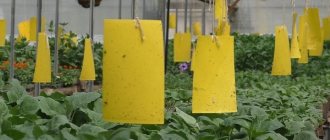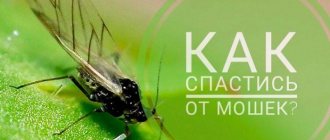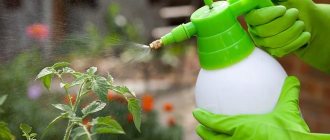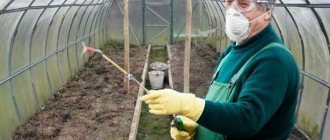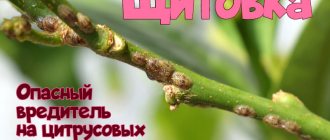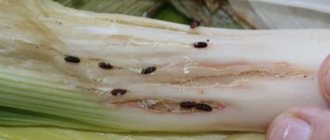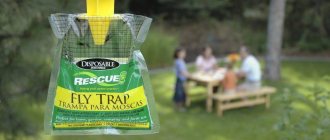Growing eggplants in central Russia is quite difficult. This vegetable crop is very heat-loving and is planted through seedlings. Eggplants cannot tolerate even short exposure to low temperatures. But despite all the difficulties that arise when growing this vegetable, gardeners manage to get a good harvest. The most important thing is to protect eggplants from the pest in time. These plants can be affected by insect pests such as whiteflies, spider mites, eggplant aphids and others.
Aphids are dangerous insects. It settles on the leaves and stems of the plant, sucks out the cell sap from it, thereby causing irreparable harm to both seedlings and adult plants. If measures are not taken, the crop may be completely destroyed, as aphid colonies grow very quickly. It is most effective to combat this pest at an early stage, before their numbers have increased significantly.
Plants in the greenhouse are most often affected. Since it creates optimal conditions for the life of this insect, namely high humidity and temperature. When the first signs appear, you need to start fighting aphids as quickly as possible in order to save the crop.
Why do aphids appear on eggplant seedlings in an apartment?
There are quite a few reasons why aphids appear on seedlings. Most often this is due to improper care of plants. Parasites can infect bushes when using contaminated garden soil.
Similar problems arise when purchasing ready-made seedlings that were grown in violation of the rules. It is worth considering that aphids affect not only eggplants. Therefore, it can move onto bushes from other plants - peppers, tomatoes, cucumbers.
Aphids on eggplants can appear when the bushes are watered too often. In this case, the soil simply does not have time to dry. High air temperatures only worsen the situation. In this case, fighting parasites becomes much more difficult.
Important! Plants with aphids are often attacked by ants. Insects carry parasites and absorb the sweet secretion they secrete.
Measures to combat spider mites in open ground
In open beds, frequent, full watering already guarantees that the pest entangling with cobwebs will not disturb the initially healthy plants. But if several individuals get on the seedlings, or females emerge from the ground after wintering, then the mite will try to take root.
- A powerful stream of water released when watering from a hose will wash away most of the pests sitting on the green eggplants.
- Walking around the beds and timely picking off dead leaves where the pest eggs are laid, followed by burning them, will remove tick foci.
- If simple steps to remove mites from eggplants do not help, then you have to switch to pollination with chemical industry products.
- Insecticides that instantly kill insects harmful to vegetables will not help against spider mites, since they do not belong to their class, but belong to spiders, so acaricides or insectoacaricides are useful here.
- To minimize the harmful effects of chemical treatments on yourself, the soil and the crop, you can try biological products - a new word in the extermination of pests that devour green shoots.
Aphids on eggplants, signs of appearance
Aphids pose a great danger to eggplants. It attacks the stems and leaves of the plant, drinking the juices from them. Parasites develop best in conditions of high humidity and temperature. Therefore, they often infect bushes that are grown in greenhouses.
There are a number of signs that help identify aphid damage to a crop. These include the following:
- white coating on the plant;
- the appearance of ants nearby;
- accumulation of insects on stems, leaves and flowers;
- sugary discharge on leaves;
- curling and yellowing of leaves, the appearance of brown spots on them;
- falling of flowers and ovaries.
Most often, aphids settle on the underside of leaves
Alternative solutions
Some remedies seem unusual, but in fact they are effective. Let's look at the most interesting options.
- Essential oils and cream. Dilute 12 drops of cedar, lavender, and tea tree essential oils in a glass of cream. Dilute the mixture in 2 liters of water. Spraying only needs to be done for 3 days.
- Sunflower oil and water. Add a glass of sunflower oil to a bucket of water. Using the product, the wooden elements of the greenhouse structure are washed - 2 procedures will be enough.
- Fumigation with tobacco smoke. The technique is perfect for processing in greenhouse buildings. Take a large iron can, light a fire in it, as soon as it flares up, add tobacco dust. When white smoke starts pouring out, place the jar in the greenhouse.
What types of aphids attack eggplants and their harm?
Eggplants suffer from 2 types of aphids. Green peach insects attack the bushes early in the season. They are green or pink in color.
In mid-summer, eggplants can suffer from cotton or melon aphids. These insects require high temperatures to develop. Adult parasites can be with or without wings. They are green-yellow or black in color.
The darker the pests, the larger their size. Small light-colored individuals are characterized by slow growth. Their colony can rarely cause serious harm to crops.
Important! Large parasites that are blue, black, green or brown multiply quickly. After just a few days, they are able to completely destroy the bushes.
Both types of parasites greatly harm bushes. Insects absorb all the juices from the eggplants, causing them to weaken. As a result, the bushes slow down in growth and die. When growing crops at home, aphids provoke the appearance of black mold on it. It interferes with the normal process of photosynthesis.
What is an insect
Aphids are small insects with six legs, whose dimensions do not exceed 4 mm. It is characterized by a high rate of spread. On the head there is a small proboscis, with the help of which the insect pierces leaves or stems and feeds on nectar.
There are two types of aphids - winged and wingless. In the first case, the parasite has the ability to move from plant to plant through the air.
Aphids are also distinguished by color. Depending on the color, the following types are distinguished:
- Green. It is a pest with an oval translucent body and brown antennae. The length of the body is on average 0.5 mm.
- Black. This is an indoor pest. Typically the parasite grows to 0.3 mm.
Adults reproduce as follows:
- the pest lays eggs - their number in one clutch can reach 150 pieces;
- the masonry waits out the winter;
- the larvae hatch with the onset of warm weather;
- It takes them seven days to mature and after a week they become adults;
- the adult insect begins to reproduce asexually;
- the aphid takes wings and moves to other bushes;
- During the autumn months, insects reproduce sexually.
Find out about poor growth of pepper seedlings here.
Reproduction occurs best at a temperature of 25-30 °C. When it drops below 20 °C, the speed decreases by 2 times. In addition, the process of maturation of adults increases.
Damage
When eggplants in an apartment are infested with aphids, there is a risk of various problems:
- Insects absorb a lot of plant sap, which causes its weakening and slower growth. If there are a large number of parasites, the bushes can dry out completely.
- Aphids produce a lot of sticky honeydew. This substance causes the growth of black mold, which prevents sunlight from reaching the bushes. This significantly slows down the important process of photosynthesis.
- Sometimes aphids spread viral infections that negatively affect the development of bushes.
When bushes are damaged, black mold forms on the leaves, which disrupts the process of photosynthesis.
Why are aphids dangerous?
The mentioned pest is the most dangerous for nightshades and eggplants as well.
She spends her life on the leaves, stems and flowers of the plant. The diet of aphids includes plant sap. Despite its small size, the danger from it for young and adult plants is obvious. In particular, aphids lead to:
- weakening of the plant due to the rapid sucking of juice;
- leaf deformations;
- drying out of young growths;
- slower growth;
- development of sooty fungus due to contamination of the leaf surface;
- development of other infectious diseases;
- destruction of the planting.
What to do and how to fight aphids (whiteflies) on eggplants at home
To get rid of aphids, you can use mechanical methods. If you have time, parasites can be collected manually. If it is absent, it is permissible to wash off the pests with plenty of water. This needs to be done carefully. To avoid damaging the bushes, it is best to use a spray bottle with water at room temperature. It is prohibited to use cold liquid to treat bushes.
This is a fairly effective way to control insects. Pests cannot stay on the bushes and fall into the ground. However, not all individuals can climb back.
Another effective way to kill parasites is the use of insecticidal soap. It contains liquid potassium salts. When the active components come into contact with insects, they die.
Note! When processing bushes, you should make sure that the soap covers all their fragments. It is especially important to apply the product to the underside of the leaves.
Let's look into the details: eggplants do not grow in the greenhouse
Infectious or viral pathologies, dampness, lack of nutrients, insect invasion are only a small part of the reasons that cause pathological changes in the structure of seedlings. Unfortunately, effective treatment cannot always be started quickly. What seems to be the culprit of the disease is, in fact, only one of the symptoms.
Botanists analyzed the possible reasons for the deterioration in the health of eggplants, highlighting the following recommendations based on the information collected:
- Lack of sunlight - noted in the case of improper placement of the greenhouse relative to the horizon. Another reason for lack of sunlight is too dense planting. The longer the fruits experience “hunger”, the less characteristic purple color they have.
- Excessive or insufficient watering - the situation is aggravated when the weather outside is dry. Against this background, the fruits become covered with cracks and gradually die off.
- Continuing the theme of watering, botanists prohibit the use of too cold water. It is enough to do this 3-4 times so that the natural humidity level in the greenhouse increases. Against this background, the risk of parasite activation increases.
- Insufficient or excessive feeding is the simplest (in terms of clinical manifestations) ailment. Eggplant leaves are curled into a boat shape. If we are talking about phosphorus starvation, then in this case the leaves are elongated at an angle of 90 degrees relative to the stem.
The promptness of the actions of a gardener who wants to establish the reasons for the deterioration in the health of seedlings should not exceed the boundaries of common sense. Before using one method or another, it is necessary to conduct a thorough inspection of the plantings.
Biological and physical control methods
When aphids appear on eggplant seedlings, what should be done in this case? The use of biological agents is considered an effective way to control pests.
Fitoverm-M
This product has a wide range of applications. It helps to cope not only with aphids, but also with mites, caterpillars, and thrips. To use the substance, 2 ml of the product must be mixed with 4 liters of water.
Akarin
To use Akarin you need to take 2 ml of the substance per 4 liters of water. Bushes must be handled with great care. This can be done in the garden or country house.
Bushes can be sprayed with special biological preparations
Why is it dangerous to treat seedlings with chemicals?
Chemical preparations effectively deal with adult insects and larvae, but spraying seedlings with insecticides is dangerous. Substances contain toxic components:
- pyrethroid;
- organophosphorus elements;
- neonicotinoid.
This can cause allergies and poisoning of animals and people. Preparation of working fluids requires strict adherence to the instructions: an overdose often provokes burns of leaf plates and the death of young seedlings. Spraying is carried out in protective clothing, wearing a respirator, gloves, and goggles.
Folk remedies
To combat aphids, it is permissible to use the following folk remedies:
- Ash. To make a useful solution, you need to take 150 g of ash per 5 liters of water. To make the composition sticky, it is worth using an additional 40 g of soap. Spray the eggplants with the prepared solution. Particular attention must be paid to the underside of the foliage. Carry out the next treatment after 7 days. The ash makes the juice bitter, which repels pests.
- Tobacco powder. To use this method, plants need to be watered with a soap solution and then sprinkled with powder. It is also permissible to mix tobacco with water and leave for a day. After this, add soap and use the composition to spray the bushes twice a week. For 5 liters of water you need to take 250 g of tobacco powder.
- Herbal decoction. Wormwood and tansy are suitable for killing aphids. To do this, plant materials must be mixed with water and left for 3 days. Then add soap and process.
- A decoction of garlic or onion peels. To do this, you will need 200 g of chopped garlic per 1 liter of water. Then mix 25 ml of infusion with 10 liters of water.
- Vinegar. For 5 liters of water you need to take 100 ml of vinegar. Treat the bushes with the solution at intervals of 3 days. This is done for 20 days.
- Ammonia. For 5 liters of water you need to take 5 ml of the substance. Treatment should be carried out once a week.
Preventive measures
A greenhouse is a closed ecosystem and it is much easier to prevent a pest from appearing in it than to later fight aphids. Considering that in a confined space there is nowhere for it to come from, it becomes clear that it is brought in from the outside - during ventilation, opening doors, with new soil, seedlings or on your clothes.
It is difficult to block such a path of penetration, but it is still possible to resist infection. To do this in the greenhouse you must regularly:
inspect the beds of cucumbers, tomatoes and peppers for the presence of aphids; remove plant debris: dead leaves, tops, roots; pay attention to weed control - they try to get rid of them as much as possible.
The set of measures includes treating the greenhouse using fumigation. A variety of checkers give good results: from tobacco to sulfur. You can buy it with insecticides in it. The smoke disinfects the soil and structural elements of the greenhouse and does not give any pest a chance. This control measure will be effective when used at the end and beginning of the season, as well as during the growing season.
Caustic soda or lime, when diluted in water, will help disinfect the contents of the greenhouse or equipment. Dilute in a proportion of 0.4-0.5 kg per 10 liters.
In addition, the list of recommendations for the prevention and control of aphids includes:
- Careful control of planting material. Purchased seedlings must be inspected for pests and undergo a quarantine period.
- Compliance with agricultural technology, namely planting dates, growing season, lighting regime, watering, fertilizing. Weak cucumbers or tomatoes that have suffered as a result of lack/excess of fertilizer or light will become easy prey for aphids. Moisten the soil only if necessary. In addition, never allow it to overflow when it gets cold.
- Control of temperature and air humidity. When growing the most popular cucumbers, tomatoes or peppers, the constant temperature should not go beyond the range of +18...+28°C, and the humidity should not be 75–90%.
- Prevent the appearance of ants and anthills. After detecting at least one, immediately inspect the entire greenhouse. Destroy them at the first threat.
There are interesting recommendations for maintaining paths in greenhouses. It is necessary to mulch them with a 5-7 cm layer of sawdust and lightly moisten them with a spray bottle. Bring in a few earwigs, then a strict aphid controller will simply settle in the greenhouse.
Growing early vegetables in a greenhouse is not the easiest job. Compared to open ground, tomatoes and cucumbers are still safer here. You just need to not miss the moment and take timely measures to combat aphids, or even better, prevent their appearance.
Chemical control methods
Effective chemicals can be used to eliminate insects. It is important to follow the instructions.
Aktara
Plantings need to be treated 2 times with an interval of 1 week. To do this, 1 ampoule is mixed with 10 liters of water. It is necessary to treat the affected bushes with the prepared composition. Irrigation must be done using protective equipment, since the composition is very toxic.
Karbofos
To use the product, 1 tablespoon of the substance must be mixed with 10 liters of water. Treat plants with the prepared solution 2 times. This is done every 7-10 days.
Fufanon
To use the product, you need to use a solution of 5 ml of the drug and 2 liters of water.
Intavir
This remedy is an analogue of the natural poison that is present in the flowers of chamomile, tansy and chrysanthemum. The drug should be used 2 times with an interval of 7 days.
Danger of aphids to plants
Aphids infect seedlings by feeding on their sap and releasing toxic compounds. Weakened plants become more susceptible to fungal, bacterial and viral infections.
The insect pest is extremely prolific. One female is capable of laying up to 150 eggs at a time. The time for transformation into an adult is 7 days. In 1 season, the generation of 10 to 17 generations of an insect is possible. Under ideal conditions (in a greenhouse), one aphid can produce 5*109 offspring. Thanks to the presence of wings, the parasite easily moves to neighboring plants.
The sugary secretions of insects - honey - attracts ants. Natural orderlies of the forest and at the same time pests of the garden and vegetable garden contribute to the preservation of the aphid population by transporting eggs and larvae of aphids, as well as protecting it from natural enemies (ladybugs).
A quick way to get rid of aphids on eggplant seedlings at home
To quickly deal with parasites, you need to do the following:
- Ventilate the room. Aphids actively reproduce in conditions of high humidity. Therefore, it is recommended to stop watering the seedlings for a while.
- Eliminate midges mechanically. To do this you need to shake the bushes a little. At the same time, the aphids will fly off. At this moment you can slam her. It is also worth placing traps near the bushes. To do this, you can pour a sugar solution or honey into suitable containers.
- Wash the bushes with laundry soap. This procedure must be carried out with extreme caution. Eggplant foliage and stems have fragile stems that can be easily damaged. It is recommended to prepare soap foam and lather the bushes with it. Leave the mixture on for a few minutes and rinse with water.
- Sprinkle the bushes with infusion of onion or garlic. You can also try other homemade recipes.
Note! To combat pests, citrus peels can be placed near the bushes. They have a pungent aroma that will repel aphids.
To destroy parasites, seedlings can be sprinkled with infusion of onion or garlic.
Common Mistakes
Sometimes aphids appear on vegetable crops due to mistakes made by the gardener:
- It’s hot and humid in the greenhouse or at home;
- the temperature does not drop at night;
- crops are watered abundantly and often.
The main mistake of a gardener is neglecting preventive measures.
During watering, pepper seedlings are carefully inspected. Having noticed alarming signals - withering of the tops, shrinking and yellowing of the foliage, a whitish coating, the plant is isolated from other plantings. The soil is sprinkled with ash, the leaves are washed with warm water. They choose a method of struggle and begin health procedures. Timely assistance will support pepper seedlings and give hope for a bountiful harvest. To avoid hassle with seedlings, preventive measures are taken.
Prevention
To avoid aphids, you need to do the following:
- Feed the plants correctly. Pests are attracted to excess fertilizer.
- Plant umbrella crops nearby. These include parsley and fennel.
- Attract birds. They eat insects, which has a beneficial effect on plant development.
Aphids settle on eggplant seedlings quite often and lead to a significant deterioration in the condition of the bushes. To cope with these pests, you can use chemical or folk remedies.
Causes of plant damage
In winter, the eggs lie under leaves or in the bark of trees. The larvae hatch three times during the summer season: in spring, early summer, and warm autumn. Aphids appear on home or greenhouse seedlings if:
- the soil and (or) seeds were not treated before sowing;
- seedlings are often watered, moisture accumulates around the roots;
- seedlings grow in a hot, damp room;
- night temperature is increased;
- an adult insect fell into the window with a flow of air.
In open ground, the spread of the parasite is facilitated by ants feeding on its sugary secretions.
Additional Information! During the winter, ants transfer pest eggs to anthills to protect the colony from destruction.
Signs of aphids
The main symptoms of seedling damage:
- suddenly, without objective reasons, the leaves dry up;
- the tops are deformed;
- a whitish sticky coating forms on the trunk and plates;
- curling, wilting of leaves;
- Small bugs crawl on the back of the leaves.
In open ground, in a greenhouse, the inflorescences of grown bushes dry out and fall off; Ants crawl in the root area and along the shoots.
Description of the pest
This very small white-winged insect, which looks very much like a moth, is called the white death of plants. It can be seen in large quantities on the underside of the leaves, where they lay their eggs, from which voracious larvae hatch after a while.
It is the latter that pose the main threat to the entire future harvest, since they suck out all the nutritious juice from the greens, and leave behind sticky marks on which fungal diseases then develop.
If the fight against these pests is not started in time, then exhausted plants begin to wither and shed blackened leaves. In addition, the plant becomes ill with various viral diseases transmitted by whiteflies. It is impossible to cure seedlings from diseases such as deformation of shoots; all that remains is to destroy them.
This pest is characterized by increased fertility, up to 15 generations are replaced in one year, and it lays up to 200 eggs during its life. The lifespan of an adult does not exceed a month.
Thus, it is easy to understand how this insect is capable of completely destroying an entire crop in a short period of time. The complete stage of transformation from egg to adult whitefly lasts up to 40 days:
- Egg.
- The larva hatches after 12 days and immediately begins to spread throughout the greenery, looking for a tasty place.
- It transforms from a larva into a nymph 7 days after it finds an ideal place to feed. Then she remains motionless for several days, gradually moving to another stage of development.
- It stays in the pupal stage for about 20 days, then the adult hatches.
Physical destruction
Aphids are not able to move particularly quickly and have very soft bodies, which makes them easy to destroy by hand. Eggplants are not a crop that can be cultivated in hundreds, so you can easily afford to spend some time plucking insects from eggplant bushes.
Some gardeners leave dead aphids directly on the plant. Apparently they like to think that this serves as a warning to other pests who are considering eggplants as their target. Of course, this is an attempt to pass off wishful thinking, but there is still some calming effect in this event.
Answers to frequently asked questions
Question No. 1 : last year, aphids took a liking to four or five of the weakest eggplants, but this year they began the invasion with the fattest ones. Why is this happening?
Answer : aphids are attracted either to weakened plants, or, conversely, to overfed ones (both are juicy and tender). Therefore, proper nutrition of eggplants is taken seriously.
Question No. 2 : aphids were discovered on the seedlings and removed. But when transplanted into the greenhouse, they appeared again. Where?
Answer : Most likely, there are ants left in the containers. Or the anthills were located in a greenhouse. The ants brought themselves new charges.
Question No. 3 : The eggplants were treated against aphids with a potent drug, but not all of them died and multiplied again. Is it a faulty insecticide?
Answer : not necessarily. If the treatment was carried out in a neglected state, when the leaves are already curling, the aphid colonies become inaccessible to the drug. In this case, it is advisable to first pick off the most affected leaves by hand and burn them. And then treat with an insecticide.
Question No. 4 : why are chemical treatments not recommended during flowering, since aphids also attack flowers?
Answer : when eggplants bloom, they direct all their energy to the formation of buds. Plants are vulnerable and susceptible to pests and pesticides. In addition, pesticides are toxic to beneficial insects living on the site: ladybugs that eat aphids, bees. The smell of eggplant flowers will attract bees to the greenhouse during ventilation and the insects will also die.
Question No. 5 : On a recently acquired plot, hybrid eggplants grow weak. They are affected not only by aphids, but also by cutworms, rot, mosaic, and late blight. Fighting and fertilizing do not produce tangible results. What's the matter?
Answer : most likely, the previous owners violated crop rotation in this area. For several years, either only eggplants or other nightshades were grown in the same place. This has led to the accumulation of diseases and pests characteristic of crops of this family. The solution is to improve the soil. In addition to mineral and organic fertilizers, green manure the soil (for example, mustard or rapeseed). Sow one green manure before winter, and another in spring. Plant plants of a different family after these shoots. The next time nightshades are allowed to be planted in this area only after 3-5 years.
Causes of whitefly
Although this insect is flying, it most often lands on greenery in the form of a larva from untreated soil. Therefore, soil for planting must be purchased in specialized stores or the soil must be disinfected by any available method before use.
In greenhouse conditions, where the air temperature is above 10 o C, the larvae begin to come to life and attach themselves to the first sprout. In addition, these insects love high humidity, which often occurs in greenhouses. Therefore, a huge group of whiteflies in a greenhouse is very difficult to destroy.
Particularly comfortable conditions for this pest are unventilated rooms and plants growing in close quarters.
Indoors, this pest can appear using a flower just purchased from a flower shop or flying in from an open window. Therefore, immediately after purchasing the plant, place it in a room where there are no other flowers for a month.
Only after not a single pest or disease is found on them is it added to the rest of the plants.
Judging by the external signs of greenery, it is easy to understand that it was attacked by a whitefly:
- A sticky coating appeared on the outside of the leaves.
- The leaves turned yellow and began to curl.
- On the inside you can see a group of small larvae.
- Various spots appeared on all the greenery.
- As soon as you slightly touch the leaf, white insects fly away from it in different directions.
